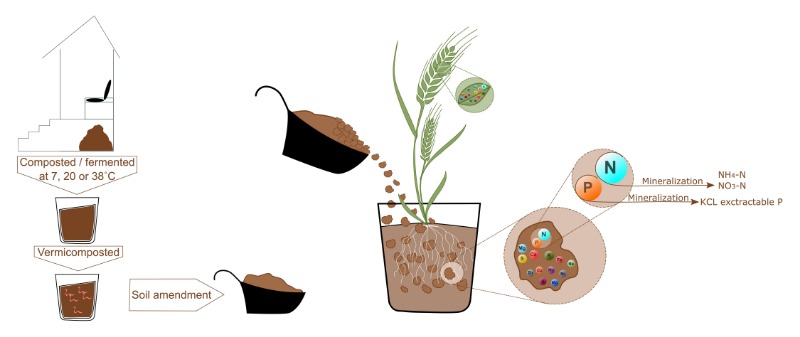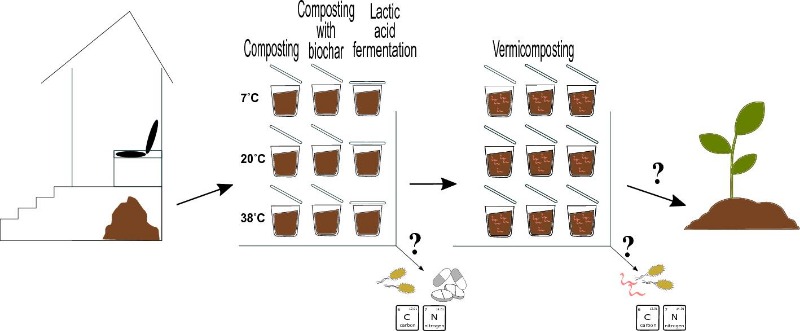- Sanitation systems
- Treatment of wastewater, sludges, organic waste, excreta
- Various other technologies and comparisons of treatment technologies
- Small-scale on-site treatment of fecal matter: comparison of treatments for resource recovery and sanitization (new publication)
Small-scale on-site treatment of fecal matter: comparison of treatments for resource recovery and sanitization (new publication)
6210 views
- Chaiwe
-

- Moderator
- Innovation enthusiast and Knowledge Management Expert in WASH and Climate Change while cross-cutting Youth and Gender Issues. CEO of CaDev_Capacity Development (An African Social Enterprise)
Less- Posts: 336
- Karma: 8
- Likes received: 116
Re: Small-scale on-site treatment of fecal matter: comparison of treatments for resource recovery and sanitization (new publication)
Thank you for sharing your publication “Small-scale on-sitetreatment of fecal matter: comparison of treatments for resource recovery and
sanitization.
I feel these are good initiatives that should continually be explored and worked on to turn waste material into a beneficial and even
profitable resource. The biggest challenge really is on the establishment of quality standards for the final products. In the case of a number of countries within Southern Africa.
There are a number of topics related to your research on the forum that I think you could contribute to, to add you knowledge and thoughts.
You can check them out here:
1. Fertiliser value of human manure from pilot urine-diversion toilets: www.susana.org/en/knowledge-hub/resource...library/details/1595
2. Vermicomposting: forum.susana.org/205-vermifilters-or-ver...ers-in-kigali-Rwanda
Regards,
Chaiwe
Skat Foundation (With financial support by GIZ and SIRWASH up to November 2023)
Chaiwe Mushauko-Sanderse BSc. NRM, MPH
Independent consultant located in Lusaka, Zambia
Emails: This email address is being protected from spambots. You need JavaScript enabled to view it., This email address is being protected from spambots. You need JavaScript enabled to view it.
LinkedIn: www.linkedin.com/in/chaiwe-mushauko-sanderse-21709129/
Twitter: @ChaiweSanderse
Please Log in to join the conversation.
You need to login to reply- SusannahClemence
-
- independent researcher
Less- Posts: 53
- Karma: 2
- Likes received: 20
Re: Small-scale on-site treatment of fecal matter: comparison of treatments for resource recovery and sanitization (new publication)
Please Log in to join the conversation.
You need to login to reply- mdoneva
-
 Topic Author
Topic Author- Working on a Ph.D. about dry sanitation systems and the utilization of the product in agriculture.
Less- Posts: 5
- Likes received: 7
Re: Small-scale on-site treatment of fecal matter: comparison of treatments for resource recovery and sanitization (new publication)
Very interesting question! But I do not know the answer. I have not investigated the topic.
I have some ideas about possible solutions but please do not think of those as advice, just ideas at the moment:
Maybe there is (or could be organized) a communal/neighborhood composter that can be used. It will depend, however, on the approval of every user to have animal feces added and evaluation of the risks depending on how the compost is used. Another idea would be to have a park service with collection points and a park-managed composter for those.
Best
Mariya
Ph.D. student at Norwegian University of Life Sciences
e-mail: This email address is being protected from spambots. You need JavaScript enabled to view it.; This email address is being protected from spambots. You need JavaScript enabled to view it.
Please Log in to join the conversation.
You need to login to reply- mdoneva
-
 Topic Author
Topic Author- Working on a Ph.D. about dry sanitation systems and the utilization of the product in agriculture.
Less- Posts: 5
- Likes received: 7
Re: Small-scale on-site treatment of fecal matter: comparison of treatments for resource recovery and sanitization (new publication)
Thank you for appreciating our work. I am very happy that you think it is valuable!
I agree that rotations with legumes would be a good alternative. However, our research is limited to what we examined and compared. Therefore, we could not conclude outside it but I see how legumes could have been mentioned as an alternative. Thank you for the remark.
Best
Mariya
Ph.D. student at Norwegian University of Life Sciences
e-mail: This email address is being protected from spambots. You need JavaScript enabled to view it.; This email address is being protected from spambots. You need JavaScript enabled to view it.
Please Log in to join the conversation.
You need to login to reply- SusannahClemence
-
- independent researcher
Less- Posts: 53
- Karma: 2
- Likes received: 20
Re: Small-scale on-site treatment of fecal matter: comparison of treatments for resource recovery and sanitization (new publication)
What is the best way to deal with dog mess picked up by dog-walkers in urban parks? Any experiences of park-scale composting? (As opposed to taking it home - as many don't have garden compost heaps)
Please Log in to join the conversation.
You need to login to reply- Heiner
-

- I am a retired organic farmer and interested in nutrient cycles. As an volunteer I now travel mainly to poor countries and together with locals I would like to find new ways of sustainable agriculture. This is beyond the regulations of IFOAM.
Less- Posts: 80
- Karma: 1
- Likes received: 67
Re: Small-scale on-site treatment of fecal matter: comparison of treatments for resource recovery and sanitization (new publication)
thanks very much to you and your colleagues for this valuable work! Hope very much more and more researchers get in this track....
A little remark from (the farmer's side) me: In vivo there will always be a loss of Nitrogen (mainly ammonia, I guess) and that is why we talk about sinks and sources. The question is whether we have to add some mineral nitrogen for good yields or if we manage to reintegrate nitrogen from the sinks into production (unluckywise the rainfall is spread all over the planet
You assume the slow mineralisation of nitrogen is responsible for low yields. Especially in dry months this is very true! Barley is grown within 3 months time and so we can expect there is some nitrate left in the soil after harvesting. By setting up a good locally adapted rotation, either catch crops or early winter crops, you still can save this late nitrate for production....but the next year.
Thanks for your work,
Heiner
Please Log in to join the conversation.
You need to login to reply- mdoneva
-
 Topic Author
Topic Author- Working on a Ph.D. about dry sanitation systems and the utilization of the product in agriculture.
Less- Posts: 5
- Likes received: 7
Re: Small-scale on-site treatment of fecal matter: comparison of treatments for resource recovery and sanitization (new publication)
Human excreta as a resource in agriculture – Evaluating the fertilizer potential of different composting and fermentation-derived products
www.sciencedirect.com/science/article/pii/S0921344921003578
In this article, I and my co-authors aimed to evaluate the fertilizer potential from the treatment products by 1) quantifying the content of macro- and micronutrients in the products, and upon application in soil, 2) examining the continued mineralization of N and changes in easily available P over time, as well as 3) determining plant yield and uptake of nutrients for a test crop under controlled conditions.
We concluded that:
"The quantification of macro- and micronutrients showed that all amendments will contribute to soil enrichment with all required elements for plant growth. Upon application to fertile soil, the amendments showed slow mineralization of nitrogen but contributed to higher growth than treatments without fertilizer. Due to the low availability of nitrogen, the yields were lower in comparison to mineral fertilizer. The main determinant of fertilizer potential was nitrogen, which was higher in the amendments obtained by active composting at high ambient temperatures (38oC). There was no clear indication that the uptake of nutrients was affected by the type of fertilizer. Our results demonstrate the agronomic value of the products from different on-site sanitation systems and determined the effect of the treatment method on the availability of nitrogen. We identified that supplementing the amendments with mineral nitrogen is a suitable approach for balanced fertilization, which limits the potential for excessive fertilization and its associated environmental impacts."
Kind regards
Mariya Kelova
Stipendiant / PhD candidate
Faculty of Environmental Sciences and Natural Resource Management,
Norwegian University of Life Science (NMBU), www.nmbu.no
Please log in or register to see it.
Ph.D. student at Norwegian University of Life Sciences
e-mail: This email address is being protected from spambots. You need JavaScript enabled to view it.; This email address is being protected from spambots. You need JavaScript enabled to view it.
Attachments:
Please Log in to join the conversation.
You need to login to reply- mdoneva
-
 Topic Author
Topic Author- Working on a Ph.D. about dry sanitation systems and the utilization of the product in agriculture.
Less- Posts: 5
- Likes received: 7
Re: Small-scale on-site treatment of fecal matter: comparison of treatments for resource recovery and sanitization (new publication)
I continued the experimental work from this article with an investigation of the fertilization potential those materials have (after the vermicomposting). The results will be available in another publication that should be available online in the next few weeks. In addition, I am working on a review of dry toilets and more specifically: small-scale on-site treatment methods for resource recovery.
Kind regards
Mariya Kelova
Ph.D. student at Norwegian University of Life Sciences
e-mail: This email address is being protected from spambots. You need JavaScript enabled to view it.; This email address is being protected from spambots. You need JavaScript enabled to view it.
Please Log in to join the conversation.
You need to login to reply- raogk
-
Less
- Posts: 11
- Likes received: 7
Re: Small-scale on-site treatment of fecal matter: comparison of treatments for resource recovery and sanitization (new publication)
Warm regards
G Kondala Rao
Please Log in to join the conversation.
You need to login to reply- Elisabeth
-
- User is blocked
- Freelance consultant since 2012
Less- Posts: 3372
- Karma: 54
- Likes received: 932
Re: Small-scale on-site treatment of fecal matter: comparison of treatments for resource recovery and sanitization (new publication)
Thank you for sharing results of your PhD project in this way! Tell us more about your project; are you already close to the end?
I am copying below the conclusions from your paper, so that this thread can be more easily be found with keyword searches in future:
Regards,Our investigation compared composting of fecal matter with lactic acid fermentation under three different temperatures. Ambient temperature had a significant effect on the composting process and the quality of the resulting material. At 7°C, composting was less active, which resulted in limited transformation and material with high numbers of fecal indicators and pharmaceuticals. At 20°C, composting was more active, and the outcome was a more stabilized material with lower numbers of fecal indicators and more efficient reduction in concentrations of a variety of pharmaceutical compounds. At 38°C, the composting process resulted in the most stabilized and sanitized material. The addition of ~ vol. 5% biochar to the composting did not yield significant differences in the measured parameters. While the active composting at 20°C and 38°C yielded more stabilized material with less E. coli and pharmaceuticals, lactic acid fermentation was comparatively successful in reducing the number of E. coli at 7°C. The lactic acid fermentation, however, was not assessed with respect to lactic acid production and retained acidity, which limited the comparison with composting. The secondary treatment with vermicomposting resulted in further maturation and stabilization of the material in all treatments, and it was particularly beneficial in reducing E. coli numbers and transforming the substrates for the treatments that were previously composted at lower temperatures, i.e., 7°C and 20°C.
The results of our investigation highlight the limitations of composting at low temperature and how other treatments as lactic acid fermentation or vermicomposting can be a valuable alternative, particularly when composting is not successful. Therefore, depending on the local conditions, possibilities, and desired qualities of the end product, different alternatives for resource recovery can be considered. Sustainable utilization of the resources from on-site sanitation treatment of human excreta will also depend on expanding the knowledge on the nutrient values in these treatment products and how they can be best utilized in the local agroecosystems.
Elisabeth
Freelance consultant on environmental and climate projects
Please Log in to join the conversation.
You need to login to reply- mdoneva
-
 Topic Author
Topic Author- Working on a Ph.D. about dry sanitation systems and the utilization of the product in agriculture.
Less- Posts: 5
- Likes received: 7
Small-scale on-site treatment of fecal matter: comparison of treatments for resource recovery and sanitization (new publication)
I am working on my Ph.D. project about dry sanitation systems and the utilization of the product in agriculture. Together with my co-authors we have published a paper that might be interesting for the SuSanA members and I am happy to share it here:
Small-scale on-site treatment of fecal matter: comparison of treatments for resource recovery and sanitization
link.springer.com/article/10.1007/s11356-021-12911-z
In the reported study, we examined treatment options for resource recovery from excreta from dry toilets. We conducted a lab-scale comparison on the effect of ambient temperatures on small-scale composting and examined lactic acid fermentation and vermicomposting as alternative treatments with a specific focus on the fate of pharmaceutical residues.
Please log in or register to see it.
Kind regards
Mariya Kelova
Stipendiant / PhD candidate
Faculty of Environmental Sciences and Natural Resource Management,
Norwegian University of Life Science (NMBU), www.nmbu.no
Ph.D. student at Norwegian University of Life Sciences
e-mail: This email address is being protected from spambots. You need JavaScript enabled to view it.; This email address is being protected from spambots. You need JavaScript enabled to view it.
Attachments:
Please Log in to join the conversation.
You need to login to reply- Sanitation systems
- Treatment of wastewater, sludges, organic waste, excreta
- Various other technologies and comparisons of treatment technologies
- Small-scale on-site treatment of fecal matter: comparison of treatments for resource recovery and sanitization (new publication)









